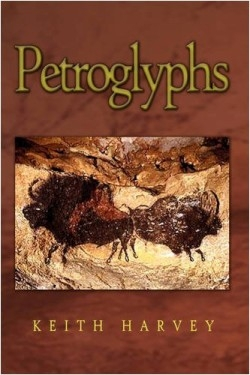Petroglyphs
There is an appropriate sense of wonder in Keith Harvey’s debut collection of poems Petroglyphs. In line after line the poet appears to be discovering the world anew and making up the answers as he goes.
In “Wille zur Macht” (named after Friedrich Nietzsche’s “will to power” philosophy) the poet writes “To align his thoughts he danced his myth / in his ebony feathers.” Although the “he” in this poem is a re-imagining of the Genesis Adam Harvey too is creating his own mythology. The centerpiece of the collection is a series of poems that chronicle the days after Adam and Eve’s expulsion from the garden. Theirs is a bleak landscape populated mainly by crows. Harvey’s crows seem more akin to Ted Hughes’s apocryphal birds in Crow than to any canonical birds in the Bible. In “The Crow People” Harvey reveals “The crows were the last to leave” perhaps an allusion to Hughes’s “That Moment” in which “the only face left in the world / lay broken” and “Crow had to start searching for something to eat.” Harvey’s poems work best when they revel in such otherworldly elements.
Petroglpyhs images carved into rock are often associated with prehistoric people. The title is fitting because most of the humans in this collection are variations of cavemen. They marvel at the world and the poems marvel with them. The poet has a real talent for evoking a setting however alien. This is of course a useful skill for a novelist and Harvey is the author of two works of fiction: Vogel Flies South and Vogel and the White Bull. He even sneaks one prose poem into Petroglyphs “G&252;nter and Paul in Clichy.” This is not the only indication of his fiction background. The narrative poems of this collection have a pleasing clarity; nothing is intentionally obscure. The length of this collection also indicates a novelist’s sensibility. At one hundred and nine pages (or nearly double an average poetry collection) more choices could have been made. Many poems rely on similar vocabulary which is less surprising on second or third encounters. Moreover some of the smaller poems feel like scraps rather than fully realized pieces.
In the end however Harvey errs on the side of thoroughness a forgivable fault. His worlds are more vivid because of repetition even if they become less marvelous. In “The Mason” the title character “drew a diagram / on rice papyrus / with a goose quill / and octopus ink.” Harvey has drawn more than diagrams in Petroglyphs.
Reviewed by
Erica Wright
Disclosure: This article is not an endorsement, but a review. The publisher of this book provided free copies of the book and paid a small fee to have their book reviewed by a professional reviewer. Foreword Reviews and Clarion Reviews make no guarantee that the publisher will receive a positive review. Foreword Magazine, Inc. is disclosing this in accordance with the Federal Trade Commission’s 16 CFR, Part 255.

